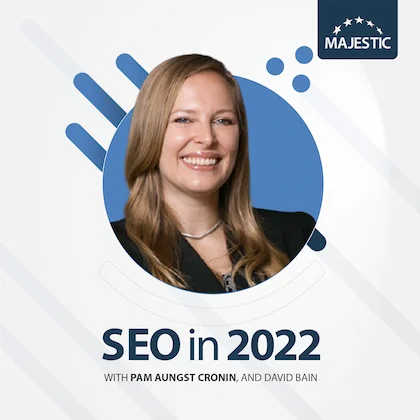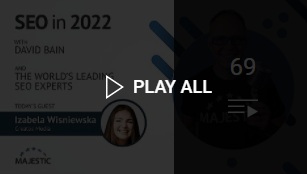-
Site Explorer
- Majestic
- Summary
- Ref Domains
- Backlinks
 New
New Lost
Lost- Context
- Anchor Text
- Pages
- Topics
- Link Graph
- Related Sites
- Advanced Tools
- Author ExplorerBeta
- Summary
- Similar Profiles
- Profile Backlinks
- Attributions
- Compare
-
Link Tools
- My Majestic
- Recent Activity
- Reports
- Campaigns
- Verified Domains
- OpenApps
- API Keys
- Keywords
- Keyword Generator
- Keyword Checker
- Search Explorer
- Link Tools
- Bulk Backlinks
- Neighbourhood Checker
- Submit URLs
- Experimental
- Index Merger
- Link Profile Fight
- Mutual Links
- Solo Links
- PDF Report
- Typo Domain
- Free SEO Tools
-
Support
- Blog

- Support
- Get started
- Tools
- Subscriptions & Billing
- FAQs
- Glossary
- How To Videos
- API Reference Guide

- Contact Us
- About Backlinks and SEO
- SEO in 2024
- Link Building Guides
- Webinars
- Blog
The debate is over - mobile UX is officially now part of SEO
Pam Aungst Cronin
Pam wishes to highlight that mobile user experience can't be forgotten about in 2022 - now that Google's Core Web Vitals incorporate mobile UX elements.

The debate is over - mobile UX is officially now part of SEO
Pam says: "Mobile user experience is officially part of SEO. Google's Core Web Vitals initiative is all the evidence we need, to say that UX metrics are finally part of our SEO goals. What was missing before was that it wasn't quantified, so it could be debated all day long. Now, Google has quantified it and made it measurable. It's here to stay."
Does mobile UX have a different set of standards compared to desktop?
Absolutely. Usability overall should be important. As with most things, Google is thinking mobile-first with page speed and indexing as well. The large ma"jority of searches occur on mobile, it's not that these things are not important on desktop, but it's more important on mobile. That's where most searches are happening, and what Google's getting pickier about.
It's also a lot more challenging. I tried to resell some concert tickets on my phone today, and it took me three or four times longer than it should have. There were issues with browser compatibility, and things moving around that I was trying to click on. Mobile is innately difficult. I'm glad they're forcing the issue because it shouldn't be this frustrating - after we've been a mobile-first world for so long."
What elements of Google's Core Web Vitals are most important to focus on for mobile UX?
"Right now, there are three that you want to focus on. The first is Largest Contentful Paint (LCP), then First Input Delay (FID), and finally Cumulative Layout Shift (CLS). Those are the three that matter right now, that Google has officially made measurable and set benchmarks to. I wouldn't doubt at all that there are more to come down the pipeline, but those are the first three to focus on for 2022.
Largest Contentful Paint is fancy wording for the biggest thing on the page, and it's about perceived load time. It can take the rest of the page longer to render and load, but Google wants the user to feel like it's happening fast by putting the biggest thing in front of them first.
First Input Delay is how long it takes for your first button to actually do something. If the browser has rendered the code and displayed a button, but it's not yet clickable, that's an example of FID. It's the delay between the user seeing the first input they may want to make, and actually being able to interact with it.
Cumulative Layout Shift is the amount of movement that you get on a page as it is continuing to load. It's the really annoying effect you have on a mobile website, when you're about to click a button, but something suddenly loads in and moves everything around and you miss the click."
What's something that an SEO can do to help to improve the LCP time?
"First you want to identify what the Largest Contentful Paint item is, according to Google. You may have several large images, hero images, and background images that are similar. Head over to PageSpeed Insights, the Google PageSpeed tool (which is essentially also the Google UX testing tool), run your site through there and look for the Largest Contentful Paint part of the report. It will tell you exactly which it is. It may not even be an image - it's whatever the largest element may be.
Then, since it usually is a very large image, it's pretty simple to optimise the file size, and maybe the dimensions. Don't upload a 4000-pixel wide image into a 40-pixel wide space - it's not going to load fast. Also optimise the weight of the file - make sure it's not four megabytes if it can be condensed down to 40 kilobytes."
Can the LCP element be below the fold, and would that impact the metric and user experience?
"The metric isn't focussed on elements above the fold, although theoretically it should be. If the LCP element is below the fold it is still important for that to load fast because whatever is above the fold may be waiting on that piece to paint. As far as the structure of the page goes, the largest things need to be loaded first. Other divs, and nested elements within them, will load afterwards."
Can CLS only be improved by the UX team, or are there SEO elements to that?
"This is the first time we've needed front-end designers to be involved, to this degree, within the SEO optimization process. Page speed included front-end, but it was mainly back-end developer tasks like server speed optimization. Cumulative Layout Shift is about how the page is painted, and in what order things are loaded. A lot of that has to do with the CSS, and that's where the front-end designers come in.
It's something that SEOs and front-end haven't had to deal with before. It's almost the newest territory to figure out: navigating how to be more helpful to those front-end CSS designers. SEOs are having to be managers now - managing content teams, front-end developers, and also back-end developers.
With Google's emphasis on mobile page speed over the last year and a half, we've become more heavily involved than ever with back-end developers. Dealing with First Input Delay is a continued discussion with them as well. It's more of a functionality issue than a design one."
How important a part of the algorithms is UX? Are you going to be de-ranked because Google perceives your UX to be poorer than your competitors'?
"There are hundreds of things that matter when it comes to SEO. Google, and other search engines, evaluate so many different things when trying to decide how high to rank a page. These three metrics are new ones, but they are among probably 300 that matter.
Think of it like playing a game, where you have to earn as many 'points' as you can to beat out your competitors. Use the cards in your deck to deal with the cards they have in theirs. If you're a leading brand in your space already, you may have an Ace of Spades in your hand - with a tonne of relevant and reputable inbound links. That is giving you 'points' in the game. If you're already earning a lot of 'points' in one category, you probably don't have to worry about losing 'points' in one of the others.
Think of it like a percentage. Consider the percentage of things that you're not tending to, or doing poorly, and how that relates to the percentage of things you're doing well."
Do you need to ensure that your UX is good on old versions of mobile operating systems as well as on current versions?
"This applies equally to page speed optimization efforts, as well as to new UX efforts. Google gives us several testing tools, but they only produce simulated data. They pretend to be a user. They will try to emulate slow mobile connections on old CPUs, operating systems, and browsers. They will pretend to be on a Moto 4, with a 1.6Mbps 3G connection. They try to be tough on you with the testing tools.
However, what matters is the field data, and what users actually experience. Google doesn't get that data from their testing tools or from Googlebot, but from Chrome user experience data. Google owns Chrome, one of the largest browsers in the world, and they collect data about what users actually experience on your site from there. That's how you're ultimately judged."
What is the frequency with which an SEO should be checking their mobile UX?
"It does need to be checked regularly, as with most things in SEO. You could optimise a single page, like your homepage, and maybe consider it good for a couple months before checking in. However, there will be all the other pages on your website that you should be testing and looking through. By the time you've finished fixing one, like Whac-A-Mole, there'll be another one that's misbehaving.
You should budget a little bit of time every month to digging through the mobile UX of your pages. The PageSpeed Insights tool is a place to get your metrics for a quick test, but Search Console is really where you will get the data for every page. It will separate the data for you into the pages that need a lot of work, and those that are doing fine. Every SEO should have some time budgeted every month to dig through any and all issues that come up in Search Console."
What is something that SEOs should stop doing to spend more time on improving their mobile UX?
"Google's algorithms are getting smarter year after year. Now, we can spend a bit less time agonising over exact data analysis when it comes to things like keyword research. Don't worry as much about picking the version of the phrase that has 2000 searches a month, or the one that has 2500, but is a bit more competitive. That's where you're able to save time because Google's algorithms are beginning to understand that 'red sneakers' has the same user intent as 'sneakers that are red'. You hit a point of diminishing returns agonising over the specific wording. The time spent on that kind of deep-dive analysis should be shifted over to improving the experience for your mobile users."
You can find Pam Aungst Cronin over at PamAnnMarketing.com.
Choose Your Own Learning Style
 Video
Video
If you like to get up-close with your favourite SEO experts, these one-to-one interviews might just be for you.
Watch all of our episodes, FREE, on our dedicated SEO in 2022 playlist.
 Podcast
Podcast
Maybe you are more of a listener than a watcher, or prefer to learn while you commute.
SEO in 2022 is available now via all the usual podcast platforms
Don't miss out
Opt-in to receive email updates.
It's the fastest way to find out more about SEO in 2025.
Could we improve this page for you? Please tell us





